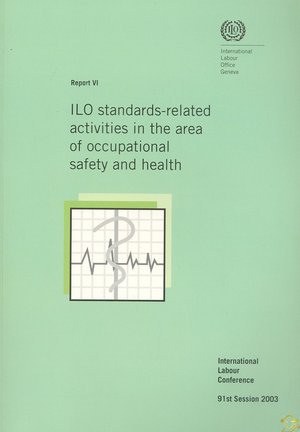ILO standards-related activities in the area of occupational safety and health
İÇİNDEKİLERContents ABBREVIATIONS AND ACRONYMS USED IN THE REPORT. INTRODUCTION............................................................ CHAPTER I. Occupational safety and health standards and other instruments Occupational safety and health: A matter for urgent global action..................... ILO action through standards and other instruments ......................................... Standards...................................................................................................... Other instruments......................................................................................... Relevant standards and other instruments.................................................... Occupational safety and health standards and other instruments over time Preliminary conclusions....................................................................................... CHAPTER II. The place of occupational safety and health in ILO activities Core responsibilities for occupational safety and health............................................. The Safe Work programme.................................................................................... Sectoral activities.................................................................................................. Extension of social protection...................................................................................... Labour inspection................................................................................................. Well-being at work............................................................................................... HIV/AIDS........................................... ............................. Social security, insurance and welfare........................................................ ......... Other ILO areas of action with significant occupational safety and health content Child labour.......................................................................................................... Occupational safety and health and small and medium-sized enterprises............ Poverty alleviation................................................................................................ Older workers....................................................................................................... Gender equality...................................................................................................... Occupational safety and health and the informal economy................................... The role of employers and workers....................................................................... Occupational safety and health and multinational enterprises.............................. International collaboration............................................................................................ Partnerships........................................................................................................... Areas of collaboration........................................................................................... Chemical safety.............................................................................................. Other areas of collaboration........................................................................... Assessment.............................................................................................. ............. Issues............................................................................................................... Preliminary conclusions........................................................................... CHAPTER III. Occupational safety and health at global, national and workplace levels The global context................................................................................................ The world of work and the environment....................................................... Demographic factors and employment dynamics......................................... The information and telecommunications revolution.................................... National-level concerns........................................................................................ Regulation...................................................................................................... Economic aspects.......................................................................................... Occupational safety and health strategies...................................................... Workplace concerns.............................................................................................. Workplace safety cultures.............................................................................. New enterprise structures.............................................................................. Preliminary conclusions........................................................................................ CHAPTER IV. Impact, coherence and relevance The impact of standards and other instruments.................................................. Measuring impact.................................. ..................................................... Ratification and supervision........................................................................ Ratification levels, intention to ratify and obstacles to ratification...... Supervision........................................................................................... Best practices in national law and practice.................................................. Standards and other instruments used as a model or as guidance............... Conventions and Recommendations.................................................... Codes of practice.................................................................................. Current standards: A coherent global model?..................................................... Overlaps....................................................................................................... Differences................................................................................................... Need for rationalization............................................................................... Comprehensive standards............................................................................ Comprehensive status of the Occupational Safety and Health Convention, 1981 (No. 155).............................................. Instruments adopted subsequent to the adoption of the Occupational Safety and Health Convention, 1981 (No. 155)................................... Current standards: A relevant response to national concerns?........................... The need for revision and possible lacunae................................................. Chemicals............................................................................................ Mechanical hazards.............................................................................. Biological hazards............................................................................... Ergonomics/maximum weight.............................................................. Psychosocial hazards........................................................................... Preliminary conclusions..................................................................................... CHAPTER V. Transforming rules into reality Promotion of standards.................................................................. Survey proposals for promotion............................................. Technical cooperation relating to occupational safety and health Core activities and partnerships...................................... Assessment of approaches...................................................... Promotion and response to needs.......................................... Possible areas for further improvement.................................. Survey responses.................................................................... Current developments in methodology.................................................. Resources................................................................................................ Knowledge management and information exchange............................................ Barriers and improvements............................................................................ Survey responses........................................................................................... Current ILO action......................................................................................... The International Occupational Safety and Health Information Centre. Training in occupational safety and health............................................. Research......................................................................................................... Preliminary conclusions........................................................................................ CONCLUSIONS.................................................................................................... Global, national and workplace occupational safety and health concerns. Impact, coherence and relevance............................................................... SELECTED POINTS FOR DISCUSSION FOR A PLAN OF ACTION , ANNEXES. I. Relevant ILO instruments - Ratifications and status.................... II. Summary of replies to the survey................................................. III. Survey responses from employers' and workers' organizations IV. Relevant ILO instruments - Statistics......................................... V. ILO global network of multidisciplinary advisory teams............. VI. Key ILO knowledge bases on occupational safety and health.. VII. International collaboration.........................................................    |



